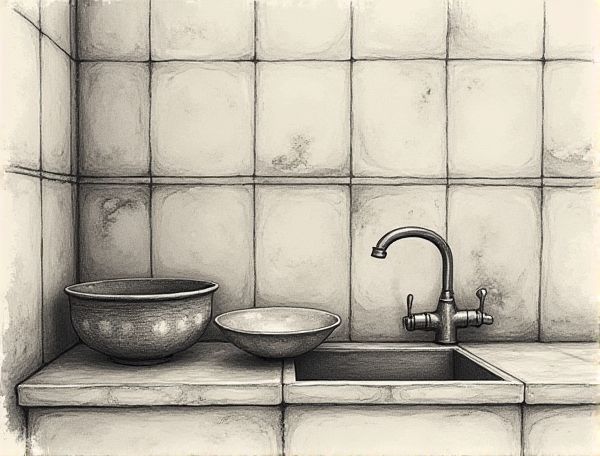
Photo illustration: Wabi-sabi home design with kintsugi-repaired tile backsplashes
Embrace the beauty of imperfection in your home design with Wabi-sabi principles, highlighted by kintsugi-repaired tile backsplashes that celebrate cracks and flaws with golden seams. Discover how these unique details transform your kitchen into a serene, authentic space by reading more in the article.
Embracing Wabi-Sabi: The Art of Imperfection in Home Design
Embracing Wabi-Sabi in home design celebrates natural materials, asymmetry, and the beauty found in imperfection, fostering a serene and authentic living space. This aesthetic highlights handcrafted textures, muted color palettes, and weathered finishes, creating a harmonious balance between simplicity and elegance.
Understanding Kintsugi: The Beauty of Mended Tiles
Kintsugi, the traditional Japanese art of repairing broken pottery with lacquer mixed with powdered gold, silver, or platinum, transforms flaws into unique, beautiful features that symbolize resilience and history. Incorporating Kintsugi-inspired elements into your home design highlights the beauty of imperfection, adding depth and character to your living space through mended tiles that tell a story. This approach not only enhances aesthetic appeal but also promotes sustainability by celebrating repair over replacement.
The Philosophy Behind Wabi-Sabi Interiors
Wabi-Sabi interiors celebrate imperfection, impermanence, and authenticity, embracing the beauty found in natural wear, organic materials, and simplicity. This design philosophy encourages you to appreciate the imperfect textures of wood, stone, and aged metals, creating a serene and timeless atmosphere. Your space reflects a mindful connection to nature and the acceptance of life's transience through understated elegance and minimalist decor.
Choosing Tiles for Kintsugi-Inspired Backsplashes
Selecting tiles for Kintsugi-inspired backsplashes involves prioritizing ceramic or glass options with gold or metallic veining patterns that mimic the traditional Japanese art of repairing pottery with precious metals. Opt for irregular, cracked designs or hand-painted details to enhance authenticity and create a visually striking, symbolic contrast within modern kitchen or bathroom spaces.
Step-by-Step Guide to Kintsugi Tile Repair
Kintsugi tile repair involves carefully cleaning broken tile pieces, applying a strong adhesive mixed with gold powder or gold-colored epoxy to the cracks, and allowing the repair to cure fully for a durable, decorative finish. This traditional Japanese method not only restores tile integrity but also enhances the aesthetic appeal by highlighting imperfections with shimmering gold veins.
Color Palettes that Complement Wabi-Sabi Design
Wabi-Sabi design embraces natural, muted color palettes inspired by earthy tones such as soft browns, warm greiges, and muted greens to highlight imperfection and impermanence. Incorporating colors like dusty rose, faded blues, and charcoal gray enhances the organic and tranquil ambiance characteristic of this aesthetic. Layering these hues with natural textures and raw materials deepens the authentic, serene atmosphere integral to Wabi-Sabi interiors.
Integrating Natural Materials and Textures
Incorporating natural materials such as reclaimed wood, stone, and bamboo enriches home design by adding warmth, durability, and unique textures that connect indoor spaces to the outdoors. Using organic textiles like linen, wool, and jute enhances sensory appeal while promoting sustainability and creating a balanced, inviting atmosphere.
Styling Tips for a Tranquil, Imperfect Home
Incorporate natural materials like reclaimed wood and linen to evoke warmth and authenticity, enhancing a tranquil, imperfect home aesthetic. Embrace asymmetry and handcrafted decor to create a personalized, lived-in ambiance that celebrates uniqueness. Soften the space with muted, earthy color palettes and textured fabrics to promote relaxation and balance.
Maintenance and Care for Kintsugi-Enhanced Surfaces
Kintsugi-enhanced surfaces require gentle cleaning with pH-neutral, non-abrasive products to preserve the lacquer and gold inlays that highlight the repaired cracks. Regular dusting with a soft cloth and avoiding exposure to direct sunlight or extreme humidity maintain the surface integrity and longevity of the kintsugi finish.
Inspiring Wabi-Sabi Homes with Kintsugi Tile Accents
Wabi-Sabi homes embody the beauty of imperfection through natural materials, earthy tones, and minimalist aesthetics that create a tranquil atmosphere. Kintsugi tile accents highlight cracks and flaws with gold or metallic lacquer, transforming damage into striking focal points and adding unique character to living spaces. This blend of Wabi-Sabi philosophy and Kintsugi art results in interiors that celebrate history, resilience, and authentic elegance.
 homedesy.com
homedesy.com